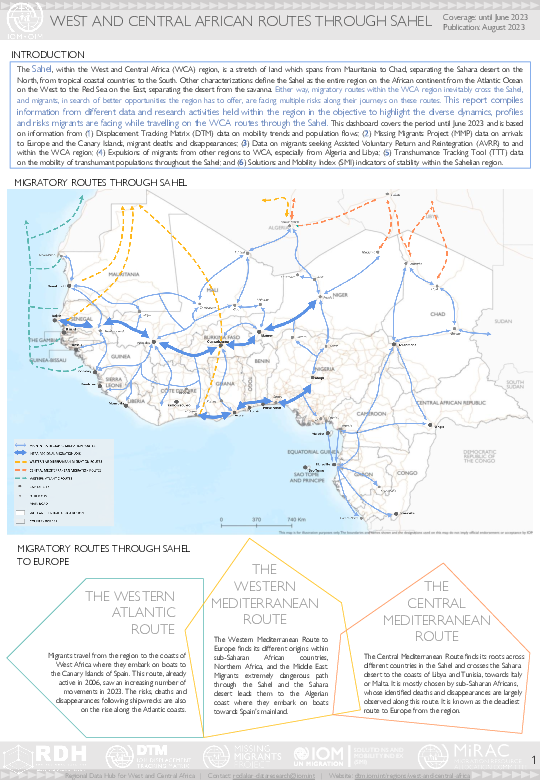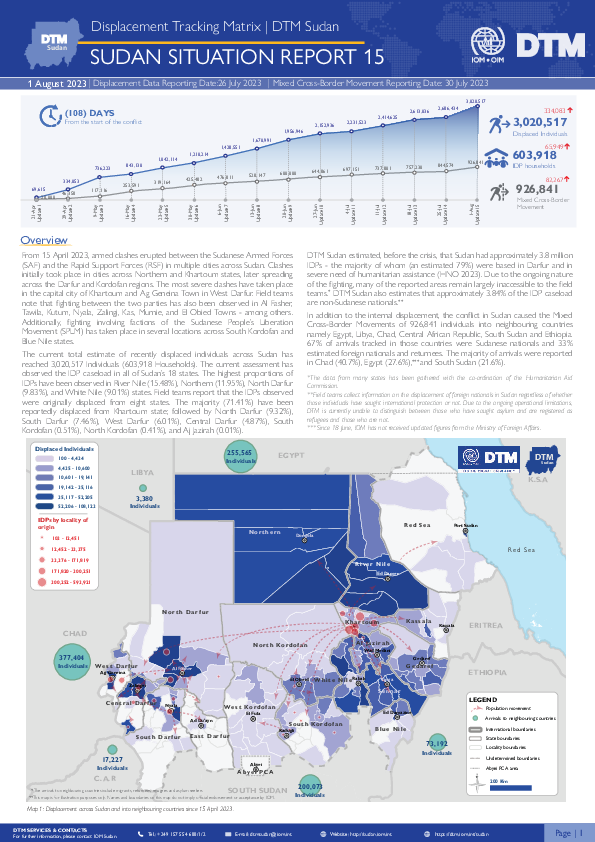-
Countries
-
Data and Analysis
-
Special Focus
-
Crisis Responses
The Sahel, within the West and Central Africa (WCA) region, is a stretch of land which spans from Mauritania to Chad, separating the Sahara desert on the North, from tropical coastal countries to the South. Other characterizations define the Sahel as the entire region on the African continent from the Atlantic Ocean on the West to the Red Sea on the East, separating the desert from the savanna. Either way, migratory routes within the WCA region inevitably cross the Sahel, and migrants, in search of better opportunities the region has to offer, are facing multiple risks along their journeys on these routes.
This report compiles information from different data and research activities held within the region in the objective to highlight the diverse dynamics, profiles and risks migrants are facing while travelling on the WCA routes through the Sahel.
This dashboard covers the period until June 2023 and is based on information from (1) Displacement Tracking Matrix (DTM) data on mobility trends and population flows; (2) Missing Migrants Project (MMP) data on arrivals to Europe and the Canary Islands, migrant deaths and disappearances; (3) Data on migrants seeking Assisted Voluntary Return and Reintegration (AVRR) to and within the WCA region; (4) Expulsions of migrants from other regions to WCA, especially from Algeria and Libya; (5) Transhumance Tracking Tool (TTT) data on the mobility of transhumant populations throughout the Sahel; and (6) Solutions and Mobility Index (SMI) indicators of stability within the Sahelian region.

Contact
DTM TÜRKIYE, mpmturkey@iom.int
Language
English
Location
Republic of Türkiye
Period Covered
Apr 01 2023
Jun 30 2023
Activity
- Flow Monitoring
- Migrants presence
According to the latest available figures from the Turkish Presidency of Migration Management (PMM), there are more than 4.9* million foreign nationals present in Turkish territory, 3.7* million of whom are seeking international protection. Most are Syrians (3,344,092* individuals) who are granted temporary protection status. In addition, international protection applicants from countries including Iraq, Afghanistan, the Islamic Republic of Iran and Ukraine constitute another group of foreign nationals.
According to PMM, there were 33,246* international protection applicants present in Türkiye in 2022, published annually. Moreover, according to UNHCR**, there were 304,697 refugees and asylum-seekers in Türkiye as of 2022. Since March 2023 the number of Syrians residing in camps has decreased by 22.
*Data source PMM, 22.06.2023
**Data source UNHCR, end of 2022
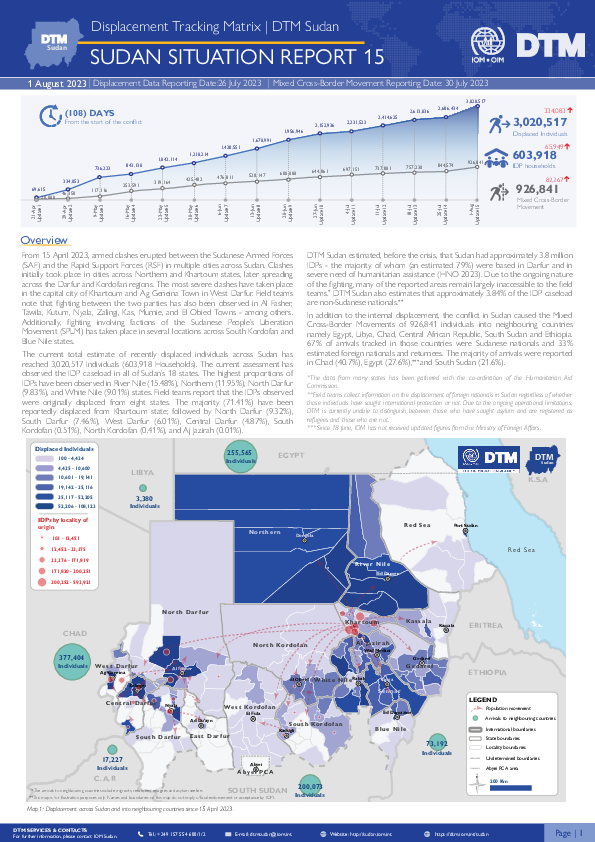
Contact
DTM Sudan; dtmsudan@iom.int
Language
English
Location
Sudan
Snapshot Date
Jul 26 2023
Activity
- Mobility Tracking
- Baseline Assessment
Overview
From 15 April 2023, armed clashes erupted between the Sudanese Armed Forces (SAF) and the Rapid Support Forces (RSF) in multiple cities across Sudan. Clashes initially took place in cities across Northern and Khartoum states, later spreading across the Darfur and Kordofan regions. Since Situation Report 14, the field team has reported outbreaks of violence across Um Kadadah, At Tina, and Kernoi localities in North Darfur; Nyala Janoub locality in South Darfur; and Kadugli locality in South Kordofan.
Highlights
- During the previous 108 days, DTM Sudan estimates that 3,020,517 individuals (603,918 households) have been displaced internally as a result of the conflict commencing 15 April 2023.
- Field teams have observed an additional 334,083 IDPs (65,949 households) since the previous update.
- The highest proportions of IDPs have been observed in River Nile (15.48%), Northern (11.95%), North Darfur (9.83%), and White Nile (9.01%) states.
- Field teams report that the IDPs observed were originally displaced from eight states. The majority (71.41%) have been reportedly displaced from Khartoum state; followed by North Darfur (9.32%), South Darfur (7.46%), West Darfur (6.01%), Central Darfur (4.87%), South Kordofan (0.51%), North Kordofan (0.41%), and Aj Jazirah (0.01%).
- Furthermore, the conflict has led to the mixed-cross border movements of 926,841 individuals.
From 15 April 2023, armed clashes erupted between the Sudanese Armed Forces (SAF) and the Rapid Support Forces (RSF) in multiple cities across Sudan. Field teams note that fighting between the two parties has been observed in Khartoum, Ag Geneina, Al Fasher, Tawila, Kebkabiya, Kutum, Nyala, Zalingi, Kas, Murnie, and El Obied Towns - among others.
- DTM Sudan estimates that, since 15 April 2023, approximately 3,020,517 individuals (603,918 households) have been displaced internally as a result of the conflict.
- Notably, the current estimate for displacement in the previous 108 days is greater than that of recorded displacement during the previous four years.
- Furthermore, an estimated additional 926,841 individuals have crossed into neighbouring countries.
Due to the ongoing nature of the fighting, many areas reportedly remain inaccessible to field teams. DTM estimates of displacement are based on preliminary reports from field teams and should be taken as estimations only.
The IDP caseload has sought shelter in locations across all of Sudan’s 18 states. IDPs have been originally displaced from eight states, including Khartoum, West Darfur, South Darfur, North Darfur, Central Darfur, North Kordofan, South Kordofan, and Aj Jazirah.
Disclaimer: DTM Sudan notes that military clashes remain continuous in many areas across Sudan in particular in Khartoum and the Darfur region – limiting humanitarian access. Additionally, field teams have reported severe telecommunication and connectivity issues, as well as escalating economic pressures which have impacted the capacity for domestic travel. As such, DTM is currently conducting remote interviews with key informants across its network and is currently unable to engage in the additional verification of these figures. Data on flows into neighbouring countries is based on available information from DTM flow monitoring networks and secondary sources.

Contact
DTM Pakistan, iomisbdtmremapteam@iom.int
Language
English
Location
Pakistan
Period Covered
Jul 01 2023
Jul 15 2023
Activity
- Flow Monitoring
Between 01 and 15 July 2023, 4,746 undocumented Afghan nationals spontaneously returned to Afghanistan, including 2,915 through the Torkham border point and 1,831 through the Chaman border point. Border authorities facilitated the return of 67 individuals due to the lack of legal documentation to remain in Pakistan. Therefore, information about these individuals is not included in the count. Although IOM identified 49,582 undocumented Afghan returnees (between 1 January - 15 July 2023) at two border crossings, this may not reflect the total number of undocumented Afghan returnees. Moreover, for this study, only the head of household or representative of the family were interviewed. This means that the number of interviews conducted by the enumerators is lower than the number of returnees recorded by IOM. Between 01 and 15 July 2023, IOM interviewed 193 respondents.
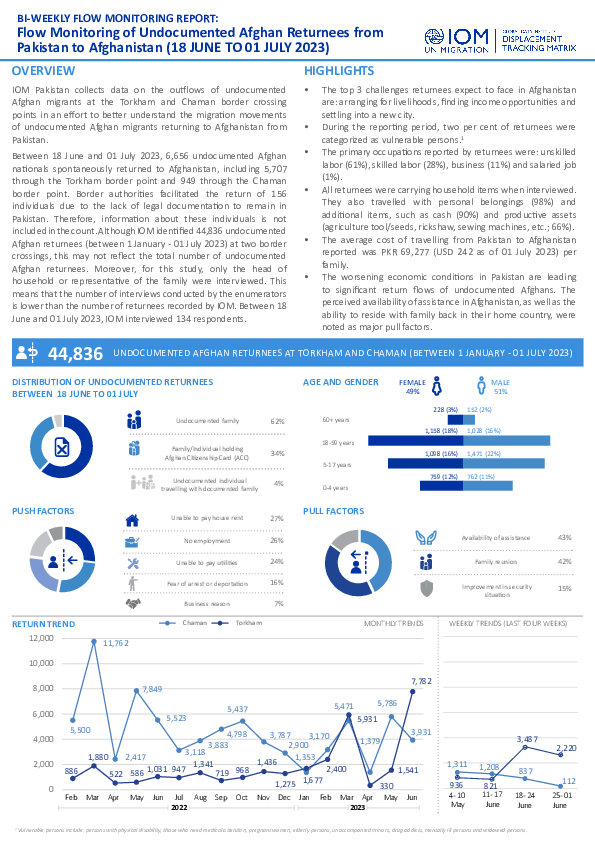
Contact
DTM Pakistan, iomisbdtmremapteam@iom.int
Language
English
Location
Pakistan
Period Covered
Jun 18 2023
Jul 01 2023
Activity
- Flow Monitoring
Between 18 June and 01 July 2023, 6,656 undocumented Afghan nationals spontaneously returned to Afghanistan, including 5,707 through the Torkham border point and 949 through the Chaman border point. Border authorities facilitated the return of 156 individuals due to the lack of legal documentation to remain in Pakistan. Therefore, information about these individuals is not included in the count. Although IOM identified 44,836 undocumented Afghan returnees (between 1 January - 01 July 2023) at two border crossings, this may not reflect the total number of undocumented Afghan returnees. Moreover, for this study, only the head of household or representative of the family were interviewed. This means that the number of interviews conducted by the enumerators is lower than the number of returnees recorded by IOM. Between 18 June and 01 July 2023, IOM interviewed 134 respondents.
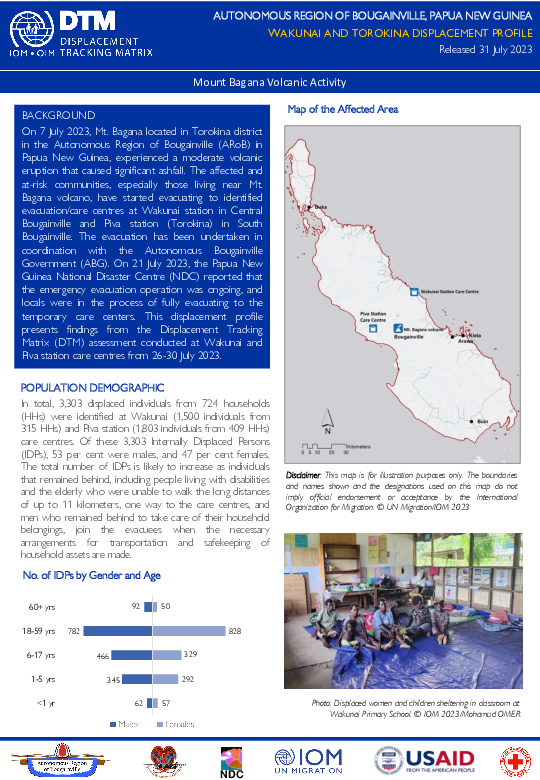
Contact
DTM Papua New Guinea, iompngmdac@iom.int
Language
English
Location
Papua New Guinea
Period Covered
Jul 26 2023
Jul 30 2023
Activity
- Mobility Tracking
- Site Assessment
- Baseline Assessment
On 7 July 2023, Mt. Bagana located in Torokina district in the Autonomous Region of Bougainville (ARoB) in Papua New Guinea, experienced a moderate volcanic eruption that caused significant ashfall. The affected and at-risk communities, especially those living near Mt. Bagana volcano, have started evacuating to identified evacuation/care centres at Wakunai station in Central Bougainville and Piva station (Torokina) in South Bougainville. The evacuation has been undertaken in coordination with the Autonomous Bougainville Government (ABG). On 21 July 2023, the Papua New Guinea National Disaster Centre (NDC) reported that the emergency evacuation operation was ongoing, and locals were in the process of fully evacuating to the temporary care centres. This displacement profile presents findings from the Displacement Tracking Matrix (DTM) assessment conducted at Wakunai and Piva station care centres from 26-30 July 2023.
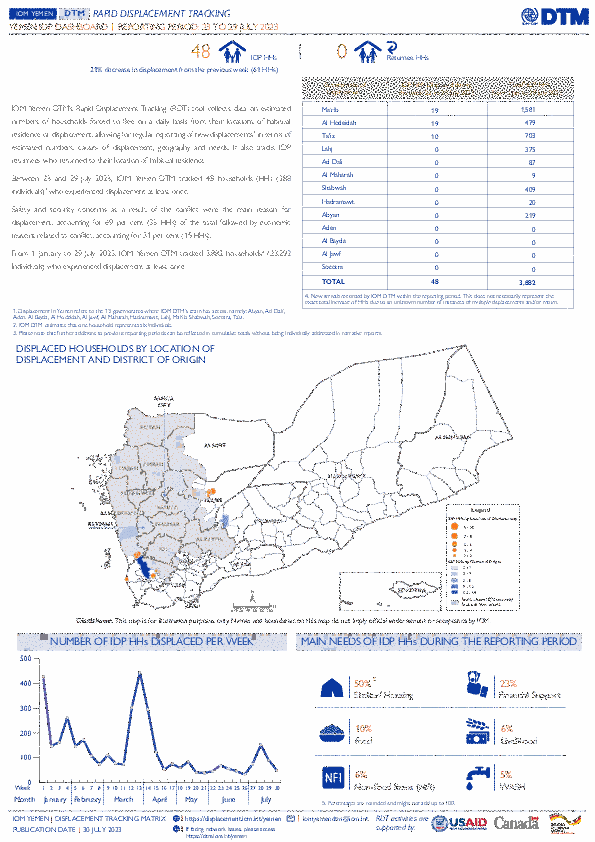
Contact
DTM Yemen, iomyemendtm@iom.int
Language
English
Location
Yemen
Period Covered
Jul 23 2023
Jul 29 2023
Activity
- Rapid Emergency Registration
- Mobility Tracking
IOM Yemen DTM’s Rapid Displacement Tracking (RDT) tool collects data on estimated numbers of households forced to flee on a daily basis from their locations of origin or displacement, allowing for regular reporting of new displacements in terms of estimated numbers, geography, and needs. It also tracks returnees who returned to their location of origin.
From 1 January to 29 July 2023, IOM Yemen DTM tracked 3,882 households (HH) (23,292 Individuals) who experienced displacement at least once.
Between 23 and 29 July 2023, IOM Yemen DTM tracked 48 households (288 individuals) displaced at least once. The majority of people moved into/within the following governorates and districts:
- Ma’rib (19 HHs) – Ma’rib City (11 HHs), Ma’rib (8 HHs) districts. Most displacements in the governorate originated from Shabwah and Sanaa.
- Al Hodeidah (19 HHs) – Hays (19 HHs) district. Most displacements in the governorate originated from Ta’iz and Al Hodeidah.
- Ta’iz (10 HHs) – Jabal Habashi (6 HHs), Al Makha (3 HHs), Mashrah Wa Hadnan (1 HH) districts. Most displacements in the governorate originated from Ta’iz and Al Hodeidah.
The majority of people moved from the following governorates and districts:
- Ta’iz (21 HHs) – Maqbanah (19 HHs), Sami (1 HH), Sabir Al Mawadim (1 HH) districts.
- Al Hodeidah (9 HHs) – Bayt Al Faqih (3 HHs), Jabal Ras (2 HHs), Hays (2 HHs) districts.
- Shabwah (8 HHs) – Bayhan (8 HHs) district.
Contact
DTM Yemen, iomyemendtm@iom.int
Location
Yemen
Activity
- Mobility Tracking
- Event Tracking
Period Covered
Jul 23 2023 -Jul 29 2023
From 1 January to 29 July 2023, IOM Yemen DTM tracked 3,882 households (HH) (23,292 Individuals) who experienced displacement at least once.
Between 23 and 29 July 2023, IOM Yemen DTM tracked 48 households (288 individuals) displaced at least once. The majority of people moved into/within the following governorates and districts:
- Ma’rib (19 HHs) – Ma’rib City (11 HHs), Ma’rib (8 HHs) districts. Most displacements in the governorate originated from Shabwah and Sanaa.
- Al Hodeidah (19 HHs) – Hays (19 HHs) district. Most displacements in the governorate originated from Ta’iz and Al Hodeidah.
- Ta’iz (10 HHs) – Jabal Habashi (6 HHs), Al Makha (3 HHs), Mashrah Wa Hadnan (1 HH) districts. Most displacements in the governorate originated from Ta’iz and Al Hodeidah.
- Ta’iz (21 HHs) – Maqbanah (19 HHs), Sami (1 HH), Sabir Al Mawadim (1 HH) districts.
- Al Hodeidah (9 HHs) – Bayt Al Faqih (3 HHs), Jabal Ras (2 HHs), Hays (2 HHs) districts.
- Shabwah (8 HHs) – Bayhan (8 HHs) district.
Population Groups
Survey Methodology
Unit of Analysis Or Observation
Type of Survey or Assessment
Keywords
Geographical Scope
Administrative boundaries with available data
The current dataset covers the following administrative boundaries
Contact
DTM Burundi, DTMBurundi@iom.int
Location
Burundi
Activity
- Mobility Tracking
- Event Tracking
Period Covered
Jan 15 2018 -May 19 2023
Since 2018, natural disasters, in particular torrential rains, floods and strong winds that occurred in Burundi affected 588,053 persons, including 134,351 individuals that have been displaced. During this period, the main affected provinces were Bujumbura Rural (131,943 affected persons), Ngozi (111,196 affected persons) and Kirundo (98,556 affected persons). Alongside the severe human impact, these natural disasters destroyed many houses, infrastructures and crop fields in the country.
Population Groups
Survey Methodology
Unit of Analysis Or Observation
Type of Survey or Assessment
Keywords
Geographical Scope
Administrative boundaries with available data
The current dataset covers the following administrative boundaries
